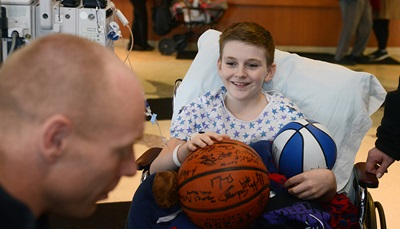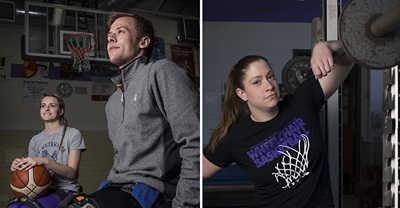As the rubbery squeaks and bounces of basketballs echoed throughout the lobby of Children’s Wisconsin, 11-year-old Cole Wagner approached slowly.
Snug in his wheelchair beneath a fleece blanket decorated with red lobsters and tethered to an IV and monitor, Cole was quiet. As players from the University of Wisconsin-Whitewater men’s and women’s wheelchair basketball team shot baskets with patients and talked a little good-natured trash to one another, Cole was not interested in playing, content instead to watch from a distance.
Cole soon caught the eye of senior Dani Ebben and head coach Jeremy “Opie” Lade. The two approached him, introduced themselves and started talking. They asked him where he was from, what his favorite sport was, who is favorite athlete was — nothing too personal or invasive, just some simple questions to help bring his guard down.
At first, Cole was apprehensive and replied in hushed, one word answers: Watertown, basketball, Lebron. Slowly, he began to open up. He mentioned that he also likes baseball and that he plays shortstop as a lefty but bats righty. Opie offered him a job as an assistant coach, when he was older, of course. And then it happened — he smiled.
Standing beside him, Cole’s mother dabbed away tears.

Nearby, Drew Selz and Laura Vacek cheered as 13-year-old Azariel Hawthrone drained basket after basket. Jordan Scheidecker tried in vain to keep up with 5-year-old Jackson Poulos, who flew around the makeshift court, chasing down loose balls and dunking them with the boundless energy of Giannis Antetokounmpo.
Jackson is eight months into a 14-month course of chemotherapy and radiation to treat his stage 4 rhabdomyosarcoma (a form of cancer that affects connective tissue, such as muscle, fat or bone).
“He loved the wheelchair basketball,” said his mother, Ashley. “It’s the little things that are huge to these kiddos.”
Members of the UW-Whitewater wheelchair basketball teams visited Children’s Wisconsin ahead of the 2017 National Intercollegiate Wheelchair Basketball Tournament, which takes place in Whitewater March 9–11. Since 2011, the two teams have won eight national championships.
For the kids, the visit was an opportunity to learn about wheelchair basketball, have some fun and forget about their illness for an hour or two. For many of the players on the team, the visit was a homecoming.
All told, six players on the UW-Whitewater wheelchair basketball teams were cared for at Children’s Wisconsin. Drew and Laura both successfully battled bone cancer. Dani and Mark Krenz were born with spina bifida. Jordan was treated for cerebral palsy. Jon Laing was born with a congenital heart defect.
“Health issues are never fun,” said Dani, “but it is cool to see how our past experiences brought us together later in life.”
Spina bifida is a birth defect that affects a baby’s spinal cord development. While the severity of symptoms can vary, Dani is completely paralyzed from the waist down.
For Drew and Laura, their disabilities came later in life. Both were diagnosed with Ewing’s sarcoma, a rare form of bone cancer that affects only 200 people in the United States each year — Laura was diagnosed in 2003 at age 7; Drew in 2005 when he was 8. While multiple rounds of chemotherapy and surgeries rid them of the cancer, both were left without full function of their affected legs.
“It was pretty tough not being able to play sports with all my friends growing up,” Drew said. “I had to be the kid that kept stats.”

From the kid who was stuck on the sidelines, today Drew is one of the best players on the best men’s collegiate team in the country. He’s also a member of the U23 national team that will compete in the World Wheelchair Basketball Championship in June. But were it not for the urging of his mother during his sophomore year of high school, Drew may have never given wheelchair basketball a chance.
“I didn’t want to try it because I thought it would be slow and soft so I fought her when she dragged me to my first practice,” Drew said. “I watched practice then saw a game three days later and fell in love.”
Laura, too, discovered wheelchair basketball as a sophomore in high school and had to overcome some initial skepticism. She was attending “One Step at a Time,” a camp for pediatric cancer patients, and a counselor brought basketball chairs for all the campers to try out.
“Originally I thought, ‘If I can walk, why would I play wheelchair basketball?’ Laura said. “I went to one practice and was immediately hooked.”
That’s a common misconception — for wheelchair basketball players, the level of disability can vary greatly. All told, there are eight different classification levels. There are players like Laura and Drew who are able to walk, albeit with limitations. And then there are players like Dani who has no use of her legs.
Laura, Drew and Dani all point to the intensity and physicality of the sport as its initial appeal. On a more emotional level, however, they’re drawn to the sense of normalcy that playing and competing gives them.

“The first time I played is something I won’t ever forget. I finally felt normal and that I fit in with everyone around me,” Laura said. “By playing wheelchair basketball, you forget that you have a disability. You feel comfortable around your teammates.”
Wheelchair basketball is played almost exactly like regular basketball — it’s five-on-five on a regulation size court with 10-foot baskets. A player in possession of the ball is allowed to push their chair two times but then must dribble once before pushing again, otherwise it’s a traveling foul.
“Getting to play on the same playing field as my peers completely changed my life,” Drew adds. “Other players understand you and your background so much more than an average person.”
The athletic feats these six former patients — and all of their teammates — have achieved speaks to their heart and dedication as well as the high quality of medical care they received growing up. They are truly an inspiration to the more than 25,000 kids who are hospitalized at Children’s Wisconsin each year and to everyone who works here.
“Seeing that other teammates went through experiences at Children’s Wisconsin shows how great of a hospital it is,” Laura said. “I have never heard them say one bad thing about it. If anything, they talk about how amazing the people are there.”

While visiting Children’s Wisconsin, players toured the Northwestern Mutual Day Hospital and other areas within the MACC Fund Center, which treats cancer and blood disorders. They also toured the neurological rehab unit. These are both areas of the hospital in which many of the players spent large portions of their childhood. Along the way, they met with patients and introduced them to wheelchair basketball, perhaps recruiting the next generation of UW-Whitewater national champions.
“Looking back now I would have loved if some told me about the game so I could have started earlier,” Drew said.
In addition to the finer points of lay-ups and dribbling, players offered inspiration and encouragement. For these patients-turned-athletes, their message to the kids was simple: don’t give up.
Dani recalled being terrified of failing at first but she took a chance and said it was one of the best decisions of her life. Jonathan remembered when he first took the court he had never used a wheelchair before and didn’t know how to stop. He may have run into a few walls, but now he and his teammates are getting ready to compete for another national championship.
“You will get through this,” was Laura’s message. “You are going to have tough times but you have to keep your mind open and find the things you love.
“This is not the end.”







